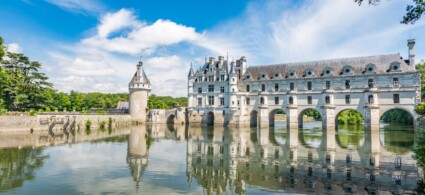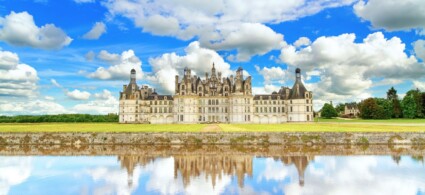

The Loire is the longest river in France. At over 1,000 km long, it winds its way through a magnificent valley covered with vineyards, finally flowing into the Atlantic Ocean.
Its course, romantic and winding, passes through picturesque villages and enchanting rural landscapes, dotted with almost 300 magnificent and imposing castles, lush vineyards as far as the eye can see and historic towns of great cultural value.
Because of its extraordinary architectural heritage, the Loire Valley has become the largest French site on the UNESCO World Heritage list, with the designation‘cultural landscape‘.
What is known by everyone as the Loire Valley is administratively made up of two distinct regions: the Centre-Valley of the Loire, the part closest to Paris, where Orléans, Bourges, Chartres, Tours and Blois are located, and the Pays de la Loire, the area extending towards the Atlantic Ocean, which includes Nantes and Angers.
Over the centuries, kings, princes and noblemen of high lineage have succeeded one another in this region, building majestic castles along the Loire river and its tributaries: from massive medieval fortresses to refined Renaissance castles, from royal residences to private estates surrounded by magnificent gardens.
The most famous is undoubtedly the grandiose and imposing Château de Chambord: with its scenic view and its double spiral staircase, its beauty is unique in the world.
Equally spectacular and not to be missed is the Château de Chenonceau, also known as the Château des Femmes, whose gardens have been designed and cared for by the various owners throughout its history.
Then discover the Château de Cheverny, which gave comic writer Hergé the inspiration to draw the Château de Moulinsart in a Tintin adventure. Of incomparable beauty are the terraced gardens, built on several levels, of the castle of Villandry.
If at the castle of Amboise, Leonardo da Vinci‘s genius worked for many years at the court of François I, the castle of Angers was born as a medieval defensive fortress, with its 17 50-metre-high towers: today it preserves the incredible 104-metre-long Tapestry of the Apocalypse.
A trip to the Loire Valley is a plunge into France’s history. Its delightful cities recount important events, thanks to their perfectly preserved historical centres.
Orleans, rich in museums and ancient quarters to visit, is the home of the French heroine Joan of Arc, who is celebrated every year with a grandiose festival, full of plays, parades in medieval costumes and evocative concerts.
Tours resembles a little 18th-century Paris: strolling through its historical centre or along its boulevards lined with typical cafés is truly evocative. While Bourges enchants its visitors with its narrow medieval alleys, framed by wonderful half-timbered houses.
Also not to be missed is Blois, with its magical and intriguing atmosphere, lying on the river and dominated by its enchanting castle. Or the emblazoned Amboise, which gave Leonardo da Vinci hospitality in the last years of his life.
If Angers unites history and modernity, with its lively and dynamic cultural scene, Saumur is the home of horses, with the Cadre Noir equestrian school, while Chinon is immersed in a bucolic landscape of lush vineyards, stretching over the hills along the La Maine river.
Finally, the Puy du Fou, one of the largest theme parks in Europe, retraces the main stages of history up to the present day, from the Vikings to the Middle Ages via the Romans.
The Loire Valley is also home to the art of living, good food and fine wines. Its gastronomy of excellence boasts exquisite dishes, which you can accompany with renowned varieties of white, red or rosé wines.
In addition, along the Vineyard Route, which covers the hills as far as the eye can see, wineries open their doors to tourists: you can take time for guided tours and tastings, which often take place in the numerous troglodytic caves carved into the tuff.
But the real joy of a trip to the Loire Valley is savouring its fine wines in the restaurants and bistros of its charming towns.
The best time to visit the Loire Valley is definitely between May and October.
We recommend late spring (May/June) as the château gardens are transformed into a riot of flowers and you can enjoy a truly unique explosion of colours. It should be emphasised that these gardens are ‘designed’ to have blooms for most of the year, so even the whole summer offers magnificent views of flowers.
While the months of July and August are ideal for the climate, dry and windy, and for the events and festivals scheduled throughout the summer, they are also taken by storm by tourists, who invade the region bringing queues and confusion to visit the castles. Prices for accommodation also rise significantly.
The beginning of autumn is also a good time: you can admire the bright colours of the vineyards and taste the new wines, accompanied by the delicacies of the table.
The quickest and easiest way to reach the Loire Valley is to book a flight by landing at one of the French capital’s two international airports: Paris Orly Airport and Paris-Charles de Gaulle Airport.
Once you land, you can rent a car conveniently at the airport and then start your itinerary in the Loire Valley. The classic tours to visit the Loire Valley all start in Paris, which is about 1.20 hours from the first location, the charming town of Chartres.
If, on the other hand, you prefer to arrive in the French capital by train, the best solution is definitely to take a TGV high-speed train.
In the Loire Valley, you will find many gites or chambre d’hotes, the French version of B&Bs, housed in beautiful period buildings: they are perfectly restored structures, often with enchanting gardens and sometimes even swimming pools.
Hotels, on the other hand, are mainly located in larger towns, such as Bourges, Tours or Saumur: boutique hotels guarantee high levels of comfort and the possibility of staying in the heart of the cities. Others are housed in manors: sleeping in a castle in the Loire Valley is an expensive but incredibly fascinating experience.
The Loire Valley stretches along the course of the Loire River between Nantes and Orleans. After the administrative modernisation of the regions in 2016, this vast area has now been divided into the regions Centre-Valley de la Loire and Pays de la Loire.







